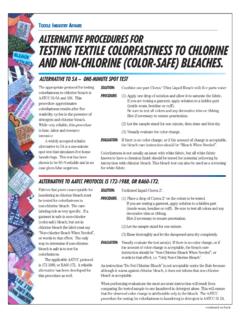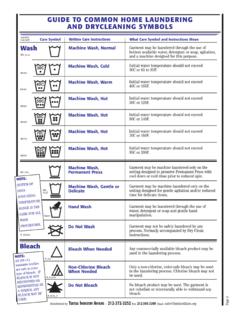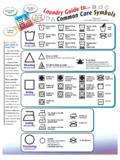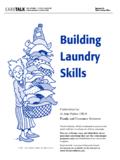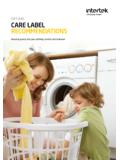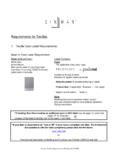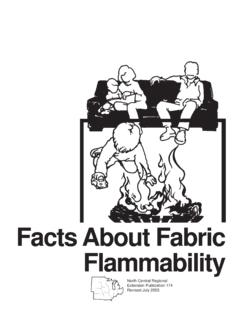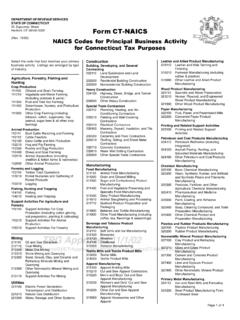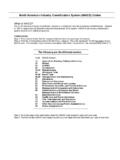Transcription of CARELABELTALKALERT! T! INDUSTRY …
1 The first step issorting it laundry sorting is important toprevent laundry problems like dye transferfrom one garment to another, shrinkingclothes and unsightly lint accumulationsover the rest of the wash. Follow carelabels, if there is any doubt about propercare. Sort laundry loads according to: Color Whites and pastels together Same color brights Dark colorsNote: Multicolored items with lots ofwhite background are best washed sepa-rately first. If colors don t bleed or run,then they can be washed with other itemsin the and Construction Separate delicate or lightweightfabrics from heavier items Separate lint givers (terrycloth) from lint catchers (corduroy)Loosely knit sweaters, lingerie oritems with delicate trim require gentlecare and need to be separated from heav-ier items like jeans.
2 Different fabrics needdifferent laundry care- be sure to read andfollow the care label of Soil Heavily soiled work or play clothes should be washed separately from lightly soiled laundry Wash diapers and soiled bed linens separately to avoid contaminating other , check, shake and take a load off your mindTaking an extra minute to checkclothing prior to washing can save seriousproblems later. Pockets with crayons,tissues, lipstick or other surprises canleave laundry streaked with shreddedtissues or a rainbow of stains. Before washing: Empty pockets Shake out loose dirt from cuffs Close zippers and other fasteners to prevent snagging and fabric tearing Mend rips or tears before laundering, to prevent further damage Tie strings and sashes loosely to avoid tangling Remove belts, pins, trim or ornamentsthat are not washableCARELABELTALKALERT!
3 FOR APPAREL / TEXTILE INDUSTRY PROFESSIONALSALERT!Sponsored by Textile INDUSTRY Affairs 2005 Textile INDUSTRY AffairsIn the good old days laundry was done withsoaps, scrub boards,wash tubs and lots ofelbow grease. Today s advancedwashing machines, hi-tech detergents andlaundry additives makewash days easier andmore successful,especially with thearray of fabrics used incontemporary laundry basics,however, haven tchanged and are moreimportant than is a quickrefresher to help getsparkling- clean results,washload EssentialsLaundry Products Successful laundry results start withthe right laundry products. Here s achecklist of laundry essentials:Detergents:Detergents work to effectively removesoil and prevent lint and soil fromredepositing on directions for theproper amount andmeasure, don tguess.
4 Extradetergent is neededfor large loads,extremely dirty clothes, orhard water. Likewise lessdetergent is requiredfor small loads, lightlysoiled clothes, or soft laundry problems are usuallycaused from using too little detergentrather than using too much. Granular detergents are recommendedfor hard water conditions and whenloads contain mud or clay soil. Liquid detergents are especially goodfor cold water washing and for cleaninggreasy, oily stains. Detergent with bleach combines color-safe bleach with either granularor liquid detergent. Detergent with fabric softener bothcleans and softens :You can keep washables whiter andbrighter longer when bleach is used inevery washload. Choosing the right bleach is easy: Household liquid bleach, identified bythe words sodium hypochlorite in theingredient listing is the only bleachthat disinfects.
5 It is also the most effec-tive bleach for stain removal andwhitening. This is the bleach of choicefor whites and colorfast pays to do the bleach-safe test whenyou think a garment should be laundry studies confirm that about52 percent of all washables are actuallysafe with household liquid laundry studies show how liquidbleach is safe for fabrics, when used asdirected. This bleach does not wear downfabrics any more than detergent alone,washload after washload. Color-Safe Bleachis, quite simply, ableach that is safe to use on washable,colored clothes. These bleaches,available in powder and liquids,remove stains and help keep colorsbright. The powdered bleaches alsohave enzymes to break up toughprotein stains, which is whythey make an excellent presoak.
6 A color-safe bleach is not a dilutedbleach. The gentle bleaching action inliquids is from hydrogen peroxide. Powderscommonly use sodium color-safe bleaches also haveoptical brighteners. This ingredient is likean invisible layer on fabrics. It reflectslight, making colors appear brighter andwhites you think acare label isinaccurate andan item should bebleachable, here s how to testthe fabric:CARELABELTALKRECOMMENDED LIQUID BLEACH AMOUNTS PER WASHLOAD Extra large1 1/2 cupsStandard large1 cupMedium3/4 cupSmall1/2 cupHandwashing(2 gallon sudsy water)1/8 cupNote: When machine washing heavily soiled clothes,add 1/4 cup more bleach to above amounts. BLEACH-SAFE TEST Mix 1 tablespoonhousehold liquidbleach with 1/4 cup water.
7 Dab 1 drop of thissolution on ahidden part of afabric such as aninside seam,hemline or cuff. Be sure to test allcolors and anydecorative trim orribbing. Wait 1 minute,then blot dry withpaper towel. Ifthere is no change,the fabric can besafely washed withhousehold bleach to your washerMany washing machines today areequipped with convenient automatic bleachdispensers for household liquid bleach. If awasher is not equipped with a liquid bleachdispenser follow either of these two methods:1. For maximum cleaning Add detergent as washer fills, then addclothes. After machine has agitated for 5 minutes,add household liquid bleach that hasbeen diluted in 1 quart ofwater. Avoid pouringmixture directly : Always use this method when using detergent with bleach Convenient While the machine fills with water, pourin liquid bleach and detergent.
8 Once agitation begins, add Soil and Stain Removers:These products are formulated to helpget clothes stain free. Their specialdetergents and enzymes penetrate stainsand break them up, helping detergents workmore effectively to wash stains Softeners:Fabric Softeners help reduce staticcling, minimize wrinkling and soften softeners are added to thefinal rinse cycle. These can be added auto-matically in washers equipped with a fabricsoftener dispenser. Otherwise, dilutedsoftener must be added manually to the finalrinse. Dryer sheets are convenient to usewith one sheet added to the dryer along withthe , temperature & softnessmake the differenceWater plays a major role in how cleanthe laundry hardness or softness, leveland temperature all affect the laundryprocess.
9 Soft water aids in the cleaningprocess, while hard water can create someproblems. If water is hard, add a watersoftener or more detergent than the productlabel recommends. Both help to soften thewater and increase the cleaningpower of the proper waterlevel and temperature is vital forbest cleaning. Laundry musthave ample room to circulate,clean and rinse properly or thedirt will end up back on theclothes. Use a hot water washfor most white fabrics and heavilysoiled colored fabrics. Warm water isrecommended for very lightly soiled orbrightly colored garments, and most otherlaundering increased concern for energyconversation, many consumers are loweringhot water heater thermostats as well aswashing in cooler water.
10 While this savesenergy, laundry results are not alwayssatisfactory. For effective cleaning, hot waterheaters should be set no lower than 120F,but hotter water up to 140F gives bettercleaning TimeBefore putting garments into the dryer,shake them out so they are loose, notbunched up. This will allow quicker check that stains are removed beforedrying. Heat can permanently set some stainsmaking them impossible to remove. Avoidoverdrying, which can cause shrinking andwrinkling. Remove clothes from the dryer assoon as it shuts off. For maximum drying effi-ciency, clean the lint filter after each load. Watertemperaturesbelow 65F won tactivate somelaundry additivesand may causelint, residue, andpoor care labelsdefine cold wateras 65- ARE SOMESUGGESTIONS TOMAXIMIZECLEANINGEFFICIENCY Presoak and pretreat stains Use appropriatebleach.

